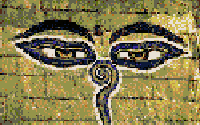
TANTRIC SHRINES and the story of DAKSHA
Tantric shrines have their own unique story to explain the
existance. Try and find the intentional language present in them,
and determine the connection between the Tantric shrine and the
religion of Shaivism, the ancient rites of nature.
The sacrifice of Daksha evokes a conflict between the vedic city
religion of Brahmanism and the Aryanites, and Shaivism.
Daksha, a Vedic sovereign and sage, arranged a great sacrifice
in honour of all the gods, except Shiva. Shiva was considered
to be an unclean, non-Vedic deity, even though Daksha had
previously given, for political reasons, the hand of his
daughter Sati (Fidelity), in a union symbolising the disputed
acceptance of the ancient Dravidian god amongst the Aryan gods.
According to the Bhagavata Purana, Daksha says, "Against my own
will, at the instigation of Brahma, I gave my daughter to this
unclean being, the destroyer of rites and social barriers, who
teaches the sacred texts to men of low birth, to shudras. Like
a madman, he haunts horrid cemeteries, surrounded with ghosts
and evil spirits. He is naked, his hair is in disorder. He
laughs, he weeps, he smears himself with ashes and wears as his
only ornament a necklace of skulls and human bones. He claims
he is of 'good omen' (shiva), but he is in reality 'of ill omen'
(ashiva). He is mad, adored by madmen, and reigns over the
spirits of darkness. May this so-called sovereign, last of the
gods, never receive a part of the offerings of this sacrifice."
According to the Shiva Purana Daksha is in turn cursed by Nandi
(Joyful), who is the companion and personification of Shiva in the
animal world. "The ignorate mortal hates the sole God who does not
return hate, and he refuses to recognise the truth. He worries only
about his homelife, and all the comprimises it implies. In order to
satisfy his interests, he practises interminable rites with a
mentality degraded by Vedic prescriptions. He forgets the nature of
the soul, since he is occupied by quite different things. The
brutish Daksha, who thinks only of his wives, shall hence-forth have
the head of a he-goat. May this stupid being, swollen by the vanity
he draws from his knowledge, togerther with all those who withy him
oppose the Great Archer Shiva, continue to live in their ignorant
ritualism.
"May the enemies of 'Him who soothes pain', whose spirit is
troubled by the odour of sacrifices and the flowery words of the
Vedas, continue to live with their illusions. May all these
priests, who think only of eating, who neglect knowledge except in
their own interests, who practise austerities and ceremony only to
earn their living, who seek riches and honours, end up only as
beggars."
The Vedic sage Bhrigu, who presided over the sacrifice, replied,
"All those who practise the rites of Shiva and follow him are but
heretics who oppose the true faith. They have renounced ritual
purity. They live in error. Their hair is tangled; they wear
necklaces of bones and smear themselves with ash. They practise the
initiation rites of Shiva, during which the use of intoxicating
liqour is consodered to be sacred. Since they despise the Vedas and
the Brahmans - the pillars of social order - they are heretics. The
Vedas are the only ways to virtue. May they follow their god then,
King of evil spirits."
The priest-king, the proud Daksha, who had invited Vishnu and
the other gods to participate in the rites of sacrifice, invited
neither Shiva nor his own daughter, Sati. Although not summoned by
her father, Sati returned to her home. Seeing that no part of the
offerings had been set aside for her husband, and insulted by her
father, she killed herself.
Then Shiva, in his affliction, created a terrifying spirit
called Virabhadra, who, at the head of Shivas' companions, the
Ganas, destroted all those at the sacrifice, sparing none. Having
cut off the head of Daksha, Shiva threw it into the fire.
Shiva himself tore out the beard of the sage Bhrigu, who poured
the oblations onto the sacred fire, he squeezed out the eyes of
Bhaga (Aryan god of inhereted goods) and broke the teeth of Pushan
(god of acquired riches).
It is here that the Tantras become involved, including the dance
of Shiva and the foundation of the first Pitha shrines.
After acting out his vengeance, Shiva took up the body of his
wife over his shoulder, and in mournful delerium danced endlessly
throughout the heavens with her corpse.
In an effort to relieve his suffering, Vishnu stealthily
followed the maddened Shiva, and one small portion after another cut
away at the dead goddess, each bit falling to the earth until
nothing remained. Shiva, released of his burden, fell into an
exhausted slumber. Each place where a peice of the goddess fell
became a powerful place, many of which became shrines and temples.
The four great primary pithas: Oddiyana, Srihatta, Purnagiri
and Jalandhara are the places where her pudenda, nipples and tongue
alighted.
There are also four types of pitha described. A temple or stupa
can simultaneouls serrve as a Tantric pitha. They are numerous,
some open, some concealed.
1. Atmapitha - shrine of the self, one's personal kula-shrine.
2. Parapitha - shrine of the Supreme, a temple.
3. Yogapitha - shrine devoted to action and learning.
4. Guhyapitha - a secret and esoteric shrine.